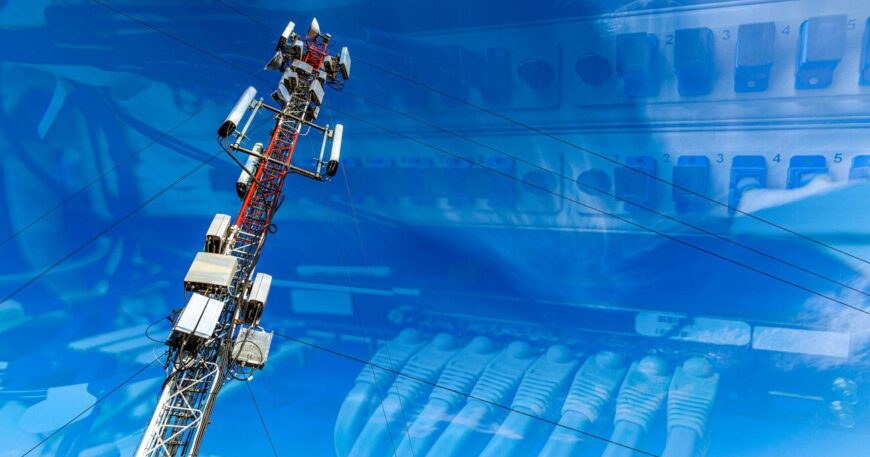It sounds easy: Screw a few MIMO antennas to the masts. Installing active equipment, retrofitting radio station baseband units, or, in the case of a centralized RAN structure, consolidating them in the central office, loading new software – the mobile infrastructure is already up to the 5G standard. But there are still a few tasks to be solved before the necessary fiber optic infrastructures (backbone) for 5G are also available to ensure this will actually work.
A different 5G perspective: Layer 1
Without close-meshed FO infrastructures on the ground, there are no sophisticated 5G services that can be broadcast via the antennas. The new, economically attractive applications and business cases of the 5G era, particularly in the business customer segment, require the real-time transport of huge amounts of data. From the core network to the radio heads, continuous and closely meshed fiber optic Layer 1 infrastructure must be available to ensure this.
Easier said than done. Fiber to the Antenna (FTTA) is posing a challenge to the various stakeholders. Manufacturers of active devices and antenna systems, tower companies, neutral hosts, mobile and private network operators, service providers, cities and their communication service providers, municipal utilities, and land and building owners – they all have to deal with the topic of cabling.

Quickly upgrading macro cells
This is about the additional Layer 1 capacity and connectivity for macro cells. It is a matter of rapidly upgrading existing cellular phone networks and masts to 5G. The Layer 1 hurdles for small cells, pico cells, private networks, and for 5G in city centers and buildings, etc. also need to be examined more closely. The task is to consolidate and centralize cabling infrastructures for macro cells as well as provide additional capacities in terms of fiber optics and power supply.
A colorful mix of existing fiber optic cabling for macro cells has to be integrated into new 5G infrastructures. This 5G upgrade inevitably leads to complex cabling infrastructures in the access, midhaul and fronthaul segments.
Naturally, cabling and connectivity have to be absolutely reliable for the demanding 5G applications to work. The focus is on flawless components, simple and therefore virtually error-free installation, interruption-free maintenance, and regular optimization options at every network level.
Planning every meter precisely
The cabling path from central offices through building and outdoor cabling to the boxes, terminals, and remote radio units can be challenging. Sometimes it’s just a few hundred meters, sometimes it’s miles. Sometimes vertical, sometimes horizontal cabling paths. Sometimes indoor, outdoor, or underground cabling for radio masts, or wall or distributed roof structures on buildings of varying heights. In addition to existing power, copper, and fiber optic cables, new, additional cable bundles with larger diameters, more copper, and more fiber optic capacity usually have to be installed. And that means opening and securely closing splice closures, shafts, distribution cabinets, riser zones, cable ducts, and boxes, or expanding them or replacing them with new ones. Depending on the location, additional groundwork, room rental, additional distribution cabinets, container solutions, or wall cutouts and roof openings may be required. Every meter of fiber optic cabling and the associated power supply for new active equipment on the 5G roadmap has to be planned precisely.
A further hurdle, for example, maybe the space available for these installations. While network operators want to make the most of 5G frequencies, it is not always possible to create more space for the equipment or build additional masts at every macro-cell location. The plot area or space on a roof is usually limited, the load capacity of the existing masts is often exhausted and the construction of additional masts requires lengthy approval procedures.
In other words, there is no «one solution fits all» approach. 5G cabling has to be planned individually to suit the location and operator.

Defining architectures
Other tasks: defining network architecture, technology, and service models. From the perspective of cabling, for example, the question to be answered is:
- Who is doing the building? Network operators, tower companies, and neutral hosts for fiber backbone networks have different priorities. Will it be a single or multi-operator location?
- Can market participants share fiber optic networks and central offices for several cell sites in a competitive manner? Can approval procedures be simplified and construction costs thus minimized?
- Is it to be a separate, direct point-to-point fiber connection or can an existing fiber optic route from another FTTx network be used in the context of fixed-mobile convergence?
- How can the effort involved in cabling be minimized and standardized in each case?
- How and where should remote radio heads, active antenna systems, associated baseband units, distributor boxes, power cabling, and other equipment be positioned?
- Which protocols and multiplex processes run on the optical networks and which connectivity do they require or are they already using?
- Does the active equipment come from a single manufacturer? Or does the relevant network operator employ a multi-vendor policy for 5G Core and 5G Radio shares because it is technically sensible, more cost-effective, or historically given? It also needs to be clarified whether existing and new products are interoperable, which interfaces, connectivity, and cabling solutions are used and whether the designs harmonize.
Looking underground
The question of whether existing FO networks could be used is very complex. Possible resources:
- Telephone, CATV, FTTH networks
- Campus and building networks
- Fiber optics from local, supra-regional utilities or from rail network operators and their communication infrastructure
This topic will be of major interest to network operators and investors as they can save money and time if they do not have to develop and build new FO routes themselves. However, evaluating, planning, and implementing suitable locations for branching off existing networks requires time and expertise as well as suitable connecting technologies and system solutions.
Cities and landowners often don’t know exactly what’s in the ground or what’s inside the switch box built years ago. There are numerous old channels, shafts, and distribution cabinets that would have space for additional and new power and fiber optic cables, and which may also be located in the immediate vicinity of macro cell locations or other interesting locations in the future network architecture.

Establishing partnerships
Anyone who finds and wants to use these resources must be ready to consider and ultimately negotiate the joint operation of fibers, capacitances, and bandwidths. In addition, lease agreements, rights of way, building permits, and public-private partnerships must be taken into account.
There is a considerable need for consulting because such partnerships in the area of fiber optic networks and the development of new radio locations for 5G, but also in particular of the locations for distribution, interconnection, and scheduling along the way, are uncharted territory at least to some extent and require joint technical planning by partners who previously either competed with each other or had nothing to do with each other. If «real» 5G infrastructures are to be created, however, these partnerships are necessary. Cities, municipal utilities, service providers, and owners of large properties have recently realized that they themselves could act as a 5G location or even as a service provider. Dedicated frequencies for so-called 5G Wireless Enterprise and Campus applications open up previously unknown options. In connection with 5G, it is possible to operate locally, commercial, and self-contained networks for the first time or to offer exclusive services and functions in a local context. However, this requires the right professional support and co-operation partners for all aspects of design, planning, implementation, optimization, and operation.
Finding products and partners
The market already offers many products for all areas of such infrastructure solutions, which can also be installed intuitively and quickly. Time plays a major role. But if individual solutions adapted to the location are required for 5G cabling, the assembly teams need more than the typical standard solution. Available housings and connectivity may not fit into the rooms at all or would overload the cabling for the antenna setups on the respective mast or for special roof construction. Homeowners and municipalities may demand discreet, integrated, and tailor-made extensions and superstructures that are not available as standard.
This requires customizing based on modular systems, as far as possible without a significant surcharge. In addition, the installations have to be protected, possibly expanded, and regularly maintained for decades. This calls for flexible partners such as R&M, who offer modular FTTA connectivity solutions, application engineering, and technical support from a single source for custom-made solutions in FO and copper technology. You can read more about R&M’s know-how as a partner on the road to the right 5G infrastructure in the specialist magazine CONNECTIONS no. 60.
R&M is in the process of gradually launching the corresponding portfolio for FTTA, PTTA, and hybrid cabling solutions, initially in the macro cell context of 5G. In doing so, it is expanding its tried and tested FTTx portfolio with additional outdoor connectivity components and individual cabling solutions -> the logical and consistent response to the convergence of mobile and fixed network infrastructures with 5G.






